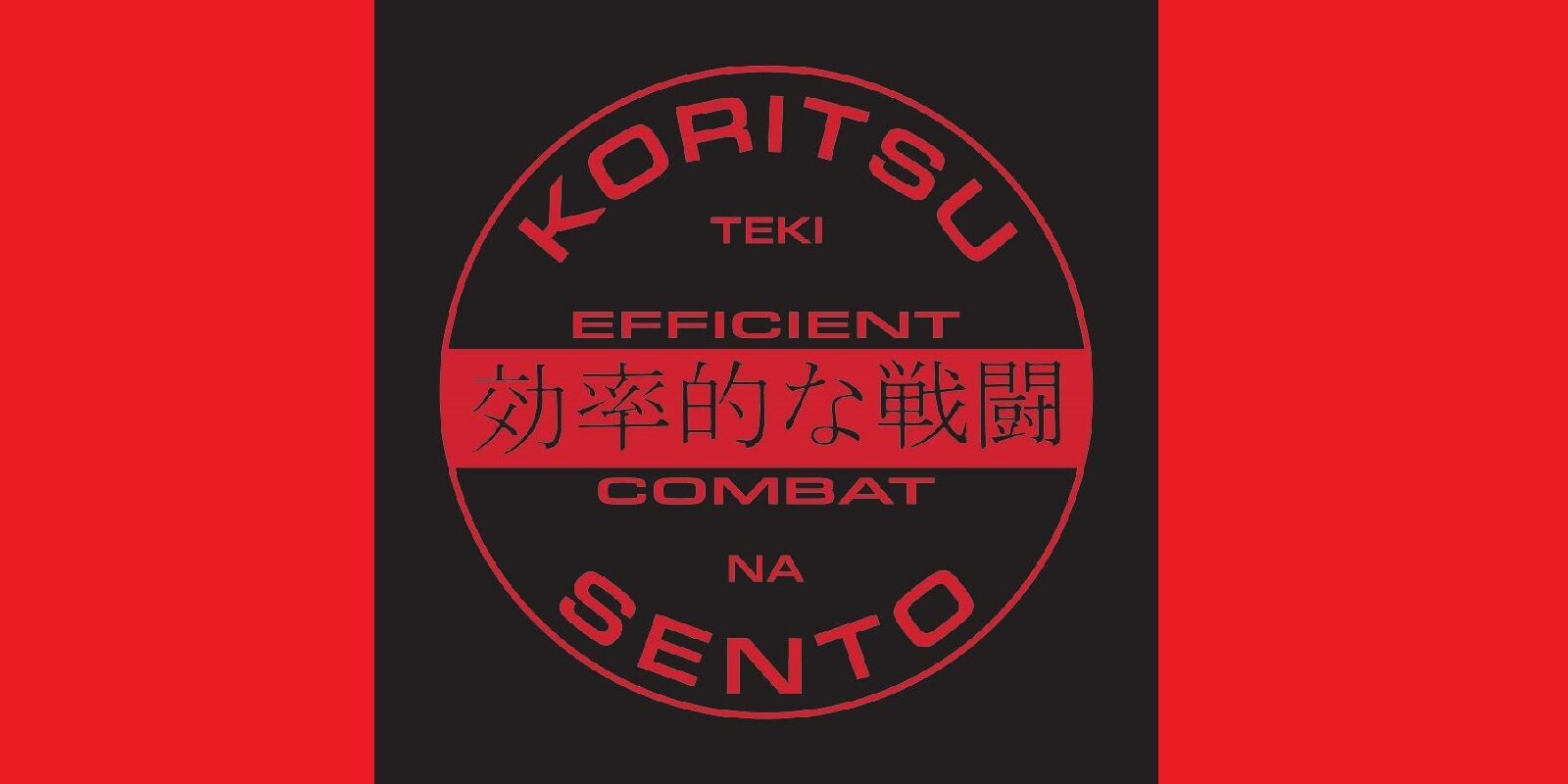September 06 | 2021
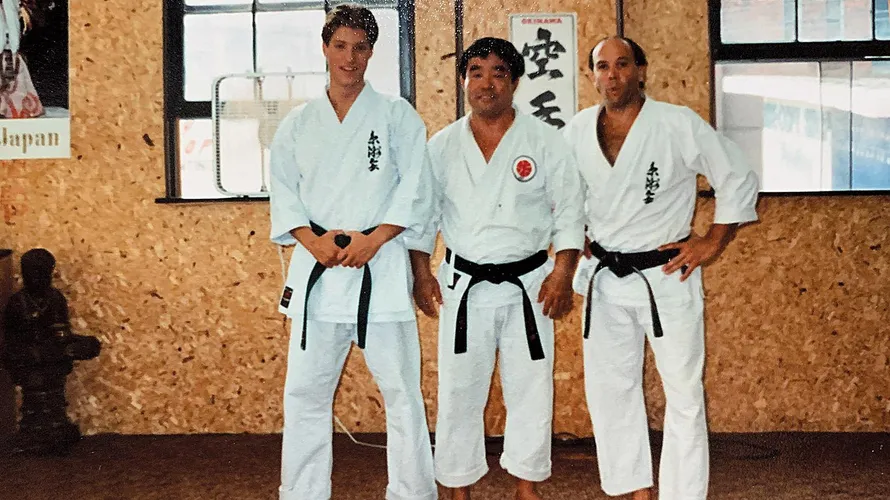
A Personal Journey to Prove It’s Not and to Reignite the Warrior Spirit
Back in 2018, when Cobra Kai was just a hit on YouTube Red and not yet a megahit on Netflix, I met Sean Kanan at the Dragonfest martial arts expo in Burbank, California. My main reason for approaching him, of course, was to ask if he would be reprising his role as Mike Barnes, the “bad boy” of The Karate Kid Part III, in the sequel series. He said that he’d love to but that nothing had been decided. Afterward, we struck up a conversation, during which I learned that Kanan is much more than an actor who played a martial artist; he has a long history in the arts and still trains. We stayed in touch over the years, and when he called to let me know he was about to take the trip that’s chronicled here, I jumped at the chance to get the report for Black Belt.— Robert W. Young, Editor-in-Chief
As I kissed my beautiful wife Michele goodbye, two things occurred to me. First, this was going to be the longest time we’ve been separated in our eight-year marriage — I barely needed both hands to count the times we’d slept apart. Second, I was about to fly to a remote area in Northern California to stay at the home of a martial arts teacher I’d never met.
How did I arrive at this moment? On the internet, of course. To be exact, it was on social media, the source of all life’s great decisions.
It was a few short weeks earlier when Adam McKinley began sending me videos of himself executing the most dynamic kicks ever. His technique was jaw-dropping. I’d never seen anything like it, not even in the movies — and I work in movies!
Adam and I began corresponding on Instagram, which led to texting and ultimately culminated in a phone call. He invited me to train with him sometime. Almost involuntarily, words escaped my mouth: “Let’s do it!”I hung up the phone, looked at my wife and said, “I think I’m going on a trip.”
At 54 years old, I was fairly certain that I wasn’t going through a midlife crisis and — let’s be honest — how many people live to be 108? Besides, I never envisioned myself fighting off middle age by purchasing a yellow Corvette convertible.
Michele studied me for a few moments and in her infinite wisdom saw something inside me that said I needed this. I needed something to inspire me, challenge me and reignite my warrior spirit. Whether she knew it or not — and she probably did — she bestowed a beautiful gift on me: the freedom to embark on a solo adventure, follow a passion and head into the unknown. Her generosity is one of the many reasons I love her.
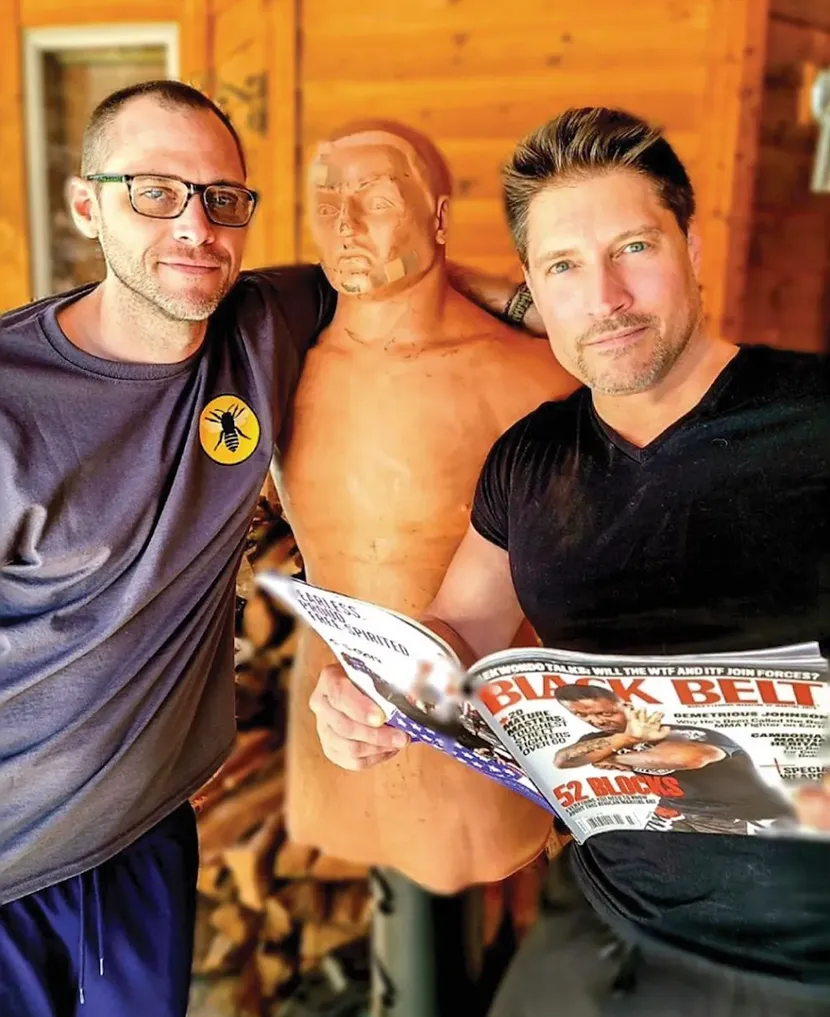
Roots
The martial arts have always had a special place in my soul. I was never a particularly gifted athlete. To say that I struggled with being bullied as a child would be an understatement. My awkward period seemed interminable. When I was 14, I timidly stepped into a shotokan karate dojo, and my life changed in ways I never could have anticipated.
My sensei, the late William “Billy” Stoner, had a profound impact on my life. It wasn’t easy being his student because he was demanding and frequently harsh. Yet that was exactly what I needed as an undisciplined teenager who was desperately struggling to gain self-confidence and find his path as a young man. Many of the lessons I learned from sensei Stoner I still carry with me. His training epitomized a famous Bruce Lee quote: “I fear not the man who has practiced 10,000 kicks once, but I fear the man who has practiced one kick 10,000 times.”
In sensei Stoner’s class, we didn’t practice complicated or flashy techniques. Instead, he drilled us in basic blocks and kicks — again and again and again. The result: To this day, my foundation in Japanese karate remains solid.
Our shotokan school eventually joined the Japan Karate Federation under Black Belt Hall of Fame member Fumio Demura. At this point, I began to learn the basics of shito-ryu genbu-kai karate. Sensei Demura had worked as Pat Morita’s stunt double in the Karate Kid movies and has appeared in numerous Hollywood films. He was a tremendous help to me when we filmed The Karate Kid Part III back in 1989. I’m in his debt as he, too, has had a major impact on my life. (I look forward to seeing sensei Demura in June when I return to my hometown of New Castle, Pennsylvania, for a tournament and banquet honoring sensei Stoner.)Over the years, I went on to study a smattering of styles, including American kickboxing, Brazilian jiu-jitsu and krav maga. I currently train in Filipino stick and knife fighting with another alumnus of the Karate Kid universe: Darryl Vidal. However, it’s been a while since I’ve seriously trained in punching and kicking, and that was certainly not at the level of the kicks shown in Adam McKinley’s TikTok videos.
It’s been more than three decades since I donned the iconic sleeveless black gi of the Cobra Kai school to portray “karate’s bad boy.” Over the ensuing years, I’ve branded a line from The Karate Kid Part III that was venomously spoken by my evil doppelganger Mike Barnes: “Your karate’s a joke!”
Now at 54, with many of the garden-variety aches and pains that come from years of training, injuries and just plain life, I faced the stark realization that I was about to learn if my karate had become a joke. Rusty? Definitely. Humorous? Possibly. But a joke? God, I hoped not!
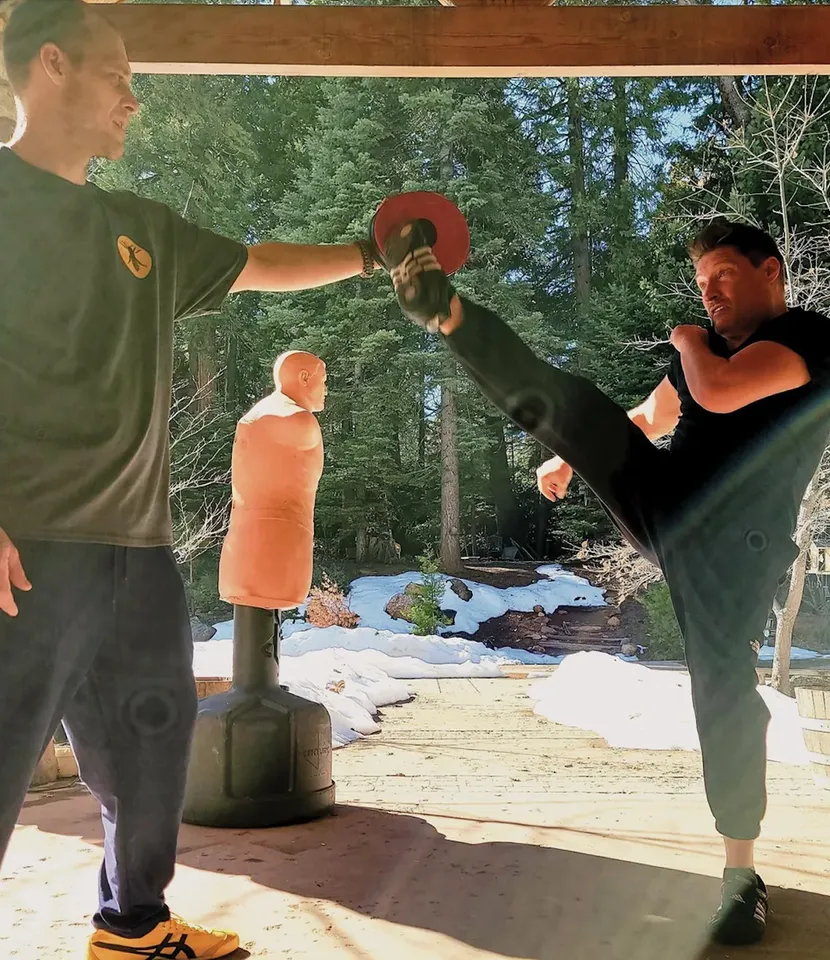
Introductions
I kissed Michele goodbye one last time. After two flights that were unremarkable — apart from the mandatory COVID-19 mask — I arrived in Sacramento, California. From there, I drove a rental car 70 miles to the small mountain town of Pollock Pines. It reminded me of the TV show Twin Peaks. Surrounded by majestic pine trees, the snow-covered town of Pollock Pines exudes a rustic and breathtaking beauty. I eventually arrived at Adam’s log-cabin home situated 4,000 feet above sea level in the Sierra Nevada. It evoked images of Rocky Balboa training in Siberia for his fight against Ivan Drago. I smiled for a moment, accepting the fact that I would at some point scream “Drago!” into the mountains, much the same way I yelled, “Are you not entertained?” during my first visit to the Coliseum in Rome.
Adam met me outside, and we exchanged greetings before walking inside to meet his wife Ilona Koti, who, I would learn, is a gourmet chef certainly deserving of a Michelin star or two. So far, I was really digging this dojo!
We enjoyed a fantastic dinner while getting to know each other. At this point, I was almost completely sure that despite the remote location, Adam was most likely not going to wear my face as a hat despite the fact that we’d met online just weeks before. He began to recount his martial arts history and the philosophy that led him to create his own style called mitsubachi ryu‚ which in Japanese means “honeybee method.”
Adam began studying at Master Castillo’s School of Tae Kwon Do in Reno, Nevada. At 12, he received his first black belt. Then came training in traditional shotokan and kuk sool under Dennis Martin, who eventually awarded him his fifth degree. He went on to train at Tiger Kung Fu Academy in Reno, where he practiced wing chun and choy li fut.
I was intrigued by his decision to study and then combine Japanese, Korean and Chinese systems. I’ve always believed that while each technique offers significant strengths, each style is not without its weaknesses. I couldn’t help but think of Bruce Lee’s concept of “formless form” and his general disdain for styles that are set in stone.
Curious about what exactly I was going to be learning this week, I asked Adam to explain his philosophy and the system he created. He paused for a second, then said, “I can sum up my martial arts philosophy like so: Imagine the taekwondo system with the power and snap of kyokushinkai. Mitsubachi ryu mixes traditional and nontraditional concepts, taking from both only that which is effective and essential.”
I was becoming more and more drawn in. I’ve always admired the traditions of the martial arts in which I’ve trained. However — and I know I’m not alone in believing this — some techniques do favor tradition over efficacy. The concept of integrating different styles and using only that which works best sounded appealing and practical.
Adam explained the difference between martial sciences and martial arts: “A martial science is derived from actual physical combat, whereas a martial art can sometimes literally be an art form and/or a means of exercise, unfortunately lacking [in attention to] what will or will not work.”
That concept certainly wasn’t going to win him any popularity awards from traditional martial artists. Then again, another pretty famous martial artist by the name of Lee ran into some of the very same problems. Adam continued: “My philosophy is simple. Treat martial arts like a buffet. In a buffet line, we typically take what looks appealing first and leave the rest. Try to embrace everything at least once to give it a chance so as not to miss something that could be incorporated.”
Realizing that I’d had a very long day, he then suggested that I turn in for the night, informing me that we’d start early in the morning. As he left me in the guest room, he smiled and said that some of our training would be “a little outside the box.” I couldn’t wait to get started.
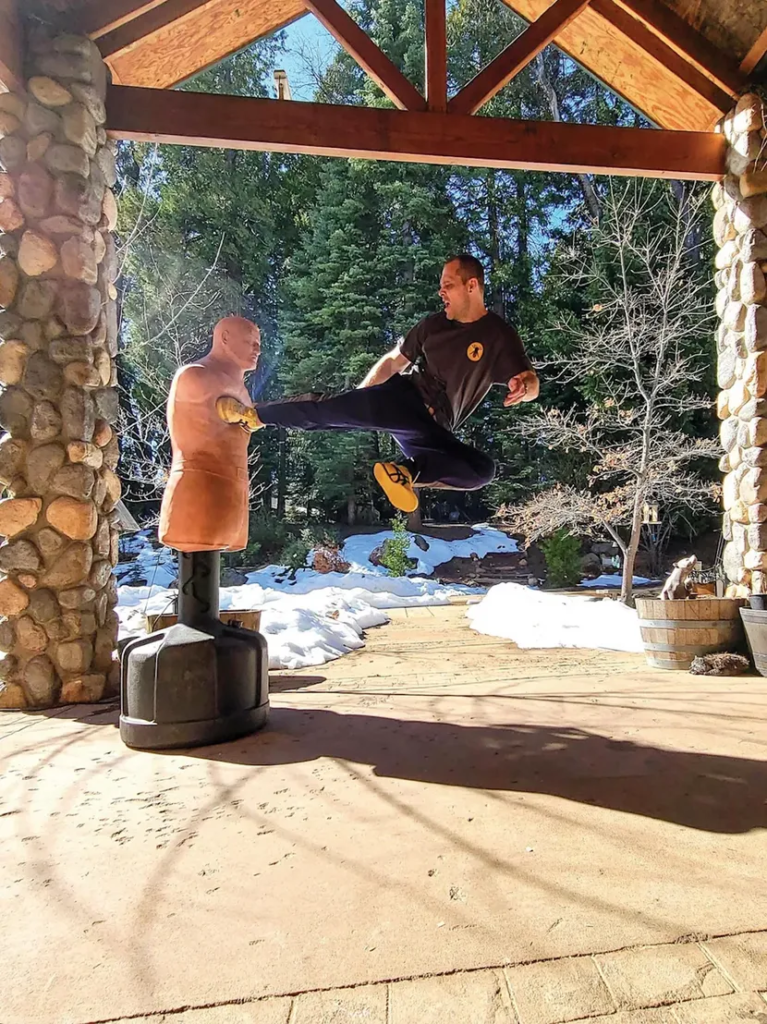
Drills
The next morning, we hiked to a massive water pipeline that seemed to stretch on forever. It had been constructed in the 1920s as part of an irrigation system. The pipe wasn’t super high off the ground, but for a guy who doesn’t particularly like heights, it was high enough.
Adam explained that our training would increase my stamina while improving my balance. We walked on it for a long time. I was in front, tentatively negotiating the occasional patches of ice and the numerous obstacles that popped up with alarming regularity. Maintaining balance required more concentration than I would’ve thought. I looked down and couldn’t help but notice some rather large animal tracks. Adam confirmed that some had come from a bear and some from a mountain lion. That instantly cured my trepidation about falling and breaking my bones, replacing it with the new possibility of being eaten by at least two predators. Out of the box, all right!
Eventually, the pipeline came to an end, and we walked a little farther on the ground to the edge of a giant canyon. Down below churned the American River. Across the canyon and over the horizon lay Carson City and Virginia City, Nevada, the same towns depicted on the Ponderosa map seen in the opening credits for the 1960s TV series Bonanza. The natural beauty was majestic and humbling. My mind and my spirit were calm and present, two essential qualities in the martial arts.
Later that day after a stretching session that was only moderately medieval, Adam introduced me to BOB, Century Martial Arts’ iconic training dummy, also known as the Body Opponent Bag. After some warm-ups, he said we’d start working on his signature move, a jump back-spinning 360-degree hook kick aka the “McKinley 360.”What?! This wasn’t exactly remedial, especially for a guy who hadn’t worked on his kicks in quite a while. But I had asked him to teach me this specific kick before I set foot on the plane. Ask and ye shall receive!
He instructed me to jump and turn 180 degrees so I could begin building my core and developing my balance. Seemed simple enough. After I’d jumped and turned to the point of dizziness, he had me position myself directly in front of BOB. Apparently foreplay was over, and it was time to, well, you get the picture.
I tried to clear my mind, put all the elements of the kick together and let go. The initial results were less than stellar. Adam is an excellent teacher — patient and thoughtful — so he continued to encourage me. I made incremental progress with each subsequent attempt. He explained that normally he would never have a new student begin with this kick for a number of reasons ranging from complexity to safety. I suddenly understood that I was being presented with yet another lesson. Almost by rote, I said, “Crawl before walk, walk before run, run before fly.”
Adam suggested I take a breather, then went to town on BOB. Every time he connected, he knocked the dummy completely horizontal. When filled with water or sand, the Century BOB XL that he trains with weighs about 290 pounds, the regular BOB about 270 pounds. And here’s the kicker, no pun intended: Sometimes it seemed like he was barely touching BOB. I decided that one way or another, before I left, I was going to lay BOB out!
As our training progressed over the next several days, I noticed some improvement. I had all but given up on the jump back-spinning 360-degree hook kick and instead settled on improving my standard spinning back kick. I was making contact consistently, but my target positioning needed work. My biggest obstacle was my flexibility. We were stretching every day and I was improving, but it was tough.
That’s when it dawned on me that this adventure was as much a mental challenge as it was physical. I’ve always had a low threshold for frustration, and I determined that if I was going to achieve success during this trip, I had to give myself a break. I had to face the fact that while I was no longer 25 years old, I also wasn’t 75. Most likely, I could do everything I did when I was 25; I just had to work a little smarter and accept that it would take a little longer. It seems that’s the pattern for lots of things as we get older.
Lessons
The days passed, and my bond with Adam grew. I realized what a great decision I’d made in coming to study with him. He continued to present me with his out-of-the-box lessons. We revisited the pipeline two more times. By the final trek, I was able to walk at a pretty fast clip on top of it, and no longer was I thinking about keeping my balance because I was balanced from within.
The following day, a truck arrived carrying at least a cord of chopped wood. A Zen saying immediately came to mind: “Before enlightenment, chop wood, carry water. After enlightenment, chop wood, carry water.” While I was fairly sure I wasn’t going to achieve Buddha status during this adventure, I began to grab the wood and stack it against a wall. I couldn’t help but wonder if “paint the fence” was coming next.
Being the evolved cat that I like to think I am, I realized that, just like Adam’s other lessons, this one had a physical component (building my strength and improving my cardio), as well as a spiritual component (putting me in touch with my humility, which is a central tenet of the martial arts). I thought, Damn, this guy’s good!
As we know, all compelling stories have a twist. OK, maybe this one didn’t have a twist, but it definitely had a curveball. Just before the week drew to a close, I received a call from Chad Assid, who had taken over sensei Stoner’s dojo in my hometown. He asked if I’d teach a youth seminar when I returned home for the event in June.
Now, I must confess that as much as I would’ve liked to say, “Absolutely, Sensei! I’d be honored,” I did not. I said I’d get back to him, intending to evaluate my progress at the end of this trip. Here I am promoting my book Way of the Cobra, espousing my strategies and philosophies for success, and there I was, second-guessing myself about teaching a seminar to a bunch of elementary school kids! I quickly called back and said, “Absolutely, Sensei! I’d be honored.”
Just goes to show you that second-guessing and that damn internal critic can sneak up on the best of us.
Now with only a day left before my departure, it was time to pull it all together. Standing in front of BOB, I cleared my mind and visualized the technique — then let it go. Spinning around, I made solid contact with BOB’s midsection and knocked him to the ground. It felt great. Was it silly to allow my validation to hinge on knocking down some inanimate object? Of course it was, but it still felt good!
I had embarked on this little odyssey to find out if my karate is a joke. In the final analysis, I learned that my karate is not a joke. Not because I can fly through the air like a hawk — or like Adam, for that matter. Because I can’t. At least, not yet. Not because I can spin like a Texas twister. Because I can’t. At least, not yet.
My karate is not a joke because at 54, I still did OK!
There was, however, an even greater lesson: In finding a new teacher and making a new friend, I had reignited my love, respect and passion for that special thing that lives within our hearts, that spirit that exists in all who love and live the martial arts.
